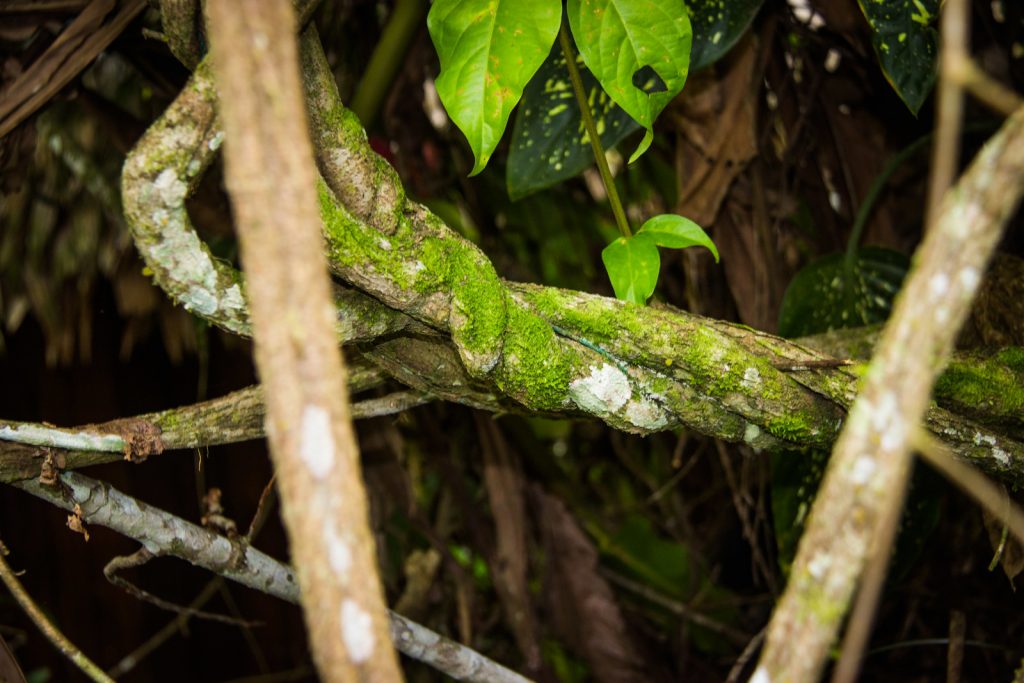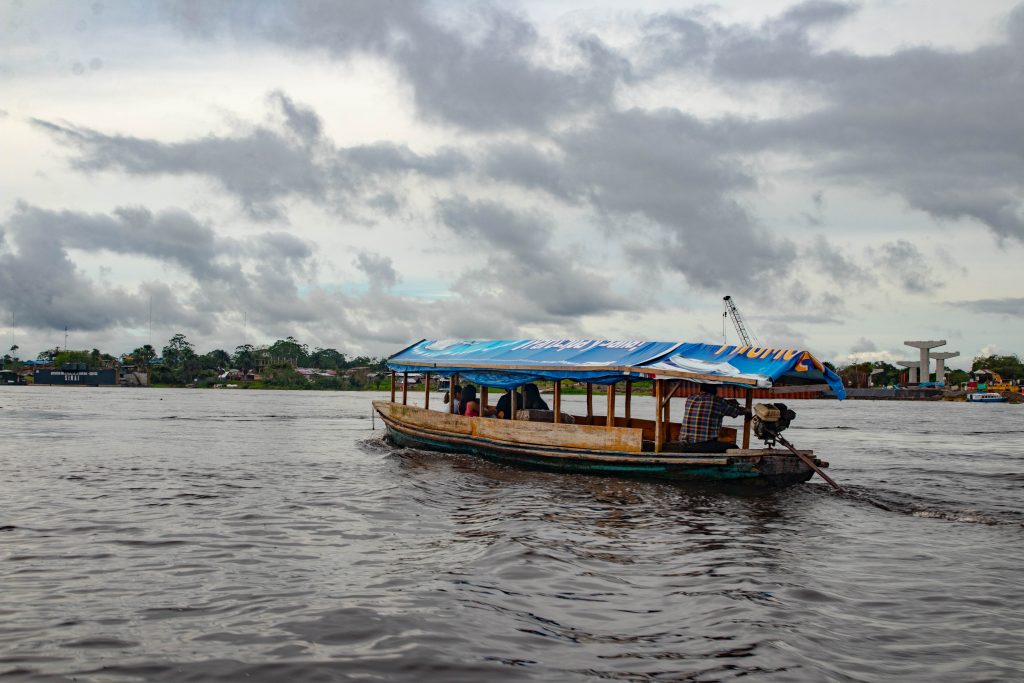Ayahuasca-focused retreat centers often refer to themselves as employing “traditional” practices but researchers and historians see things differently.
Once called “the work of the devil” by Christian missionaries in the 16th century and now one of the biggest tourist attractions in South America, ayahuasca has had an impact on humans for centuries. It has become a symbol and staple of the global south’s indigenous population, specifically the ones located near the Amazon rainforest.
Its properties of healing, introspection and spiritual awakening have become almost the de facto, over simplistic identity of not only the vine itself but also the communities that have used them for hundreds if not thousands of years.
Promises of insight into one’s own psyche, through powerful ceremonies that involve vomiting, interacting with divine entities and singing icaros (the songs used by shamans in these sessions), dominate the discussion around the phenomenon.

Celebrity participation as well as the overall view of this exotic—and expensive—trip to the jungle sets up expectations for an experience of something ethereal and interdimensional. It contributes to a general view of what is to be expected from engaging with such an otherworldly experience in this specific and marvelous setting.
The retreat centers responsible for these experiences often embrace these assumptions and promises, making them the center of their marketing and mission.
Adam Aronovich is a researcher and doctoral candidate in Anthropology and Communications at Universitat Rovira i Virgili in Catalonia. He has spent years in the Peruvian Amazon conducting extensive research and fieldwork, interviewing and assessing the work of retreats throughout the region. He has collaborated with a number of important institutions including ICEERS and the Center for Psychedelic Research at Imperial College.

Aronovich presents a different view to the aforementioned phenomenon, one that takes into consideration the broader implications of these retreat centers and all the things they offer.
“Retreat centers are 100 percent Western. They are new inventions. Many centers claim to follow tradition and the marketing sells us [a system] working with indigenous traditional medicines. All of that is really marketing,” he said.
The methods, intentions and promises promoted by these centers are often far from what truly traditional communities from the same areas participate in. It is a deep and multifaceted difference that Aronovich observes within retreats in the Amazon and global south, from a simple deviation such as participants actually drinking the ayahuasca brew to the psychological developments that occur as a result of these experiences.
“[Centers] fall very short from actually being authentic or traditional because they cater to a very specific view of the Western psyche and the Western social construct, which is really about healing culture,” he said. “That’s where our ideological market based presets come into play, which is one of the things that [Westerners] are seeking from that experience, which is completely different from what most indigenous people seek from that experience.”
These centers promote a number of expectations for visitors who are able to pay the often expensive fees for taking a journey that will supposedly change their lives for the best.
Arkana Spiritual Center—located in Iquitos, Peru—brandishes “Discover your true self,” as their primary slogan on their website. They go on to describe their devotion to healing visitors of their “deepest wounds,” and offering an opening to a path for a “meaningful and fulfilling life.”
Hummingbird Healing Center—also located in Iquitos—offers a similar tale with retreats for “transformation, healing and growth,” available for up to $4300.
Arkana’s services reach just under $5000 for a 14 day retreat expedition.
These centers can be found in Peru and other countries like Brazil, Venezuela and Ecuador. Arkana, specifically, includes packages that involve visits to Machu Picchu as well as others that are more focused on regions touching the Amazon rainforest.
Retreats like these also make sure to mention their devotion to utilizing traditional methods of healing, hiring authentic and experienced shamans as well as sacred practices like the icaros songs. It’s part of the entire image of these centers where the genuine connection to the spiritual nature of ayahuasca ceremonies is the biggest sell.
While the promises sound wonderful and appealing to those interested in exploring their inner selves and consciousness, it’s clear that they are only open to those who can afford it. Although these services certainly do help people and often fulfill what they propose, the marketed and capitalistic nature of the centers themselves beg the question of just how traditional are these offerings and practices.

Individualism and Capitalism
“That hyper individualistic focus, I think, is misguided in the sense that it is taking away really valuable resources [from] well-meaning people that really want to address these existential concerns and catastrophic risks and environmental collapse. Instead of doing that, [they] are just ruminating and obsessing about their own worlds,”
Adam Aronovich
Aronovich connects the overall view on health and medicine in the West to the practices seen within retreat centers. Without even mentioning what indigenous communities would use substances like ayahuasca for, the general direction and mission of those engaging and facilitating these practices is clearly geared towards this specific audience.
“The whole idea of healing is a very Western, modern thing…Like we’re always healing from something that has to do with a modern, luxury, consumerist world,” Aronovich explains.
As mentioned before, many, if not most, retreat centers carry banners that emphasize a promotion of mental health and a transformative experience. People who are in a difficult chapter in their lives, people seeking to discover more about themselves and even people who want a sort of creative spark are targeted through these slogans.
“In the West, for the last hundred years or so, we kind of got used to the fact that if something is wrong with us, we could go to a doctor, we could diagnose [the problem]. We can get prescribed medicine or treatment and then we become passive individual consumers of whatever thing is being handed down to us. What is oftentimes the treatment and the diagnosis [of the] illness is often entirely focused on the individual,” he adds.
It is through this paradigm that Aronovich finds the main differences between what is known to be the traditional purposes of using substances like ayahuasca and what is the modern retreat center thinking. Although his work isn’t necessarily involved in trying to remedy these differences, Aronovich hopes to see a greater awareness of how focused these practices are towards individualism.

“The individual is a primary unit and everything that addresses individual suffering, trauma and healing paths has the highest value. Something you would hear a lot in retreat centers—and as facilitators repeat these things, they become cliches—is that the best gift you can offer the world is your own self transformation,” Aronovich said.
The entire philosophy behind these experiences centers on individuals healing themselves first and foremost, before they can go on to spread any sort of positive thinking or constructive change. It, perhaps purposefully, creates a loop where people are hyper focused on completing a personal mission of changing themselves to an arbitrary point of becoming worthy or becoming enlightened enough to begin to enact change.
“That hyper individualistic focus, I think, is misguided in the sense that it is taking away really valuable resources [from] well-meaning people that really want to address these existential concerns and catastrophic risks and environmental collapse. Instead of doing that, [they] are just ruminating and obsessing about their own worlds,” he said.
While Aronovich says there is nothing wrong with this, he does believe that there should be a balance present at these retreat centers, which he finds are set up to be extremely biased towards personal growth and healing.
He says that it is a result of the capacity of neoliberalism and late capitalism to be able to shift a revolutionary idea and appropriate it towards something that benefits the system. Rather than use the potential of a substance like ayahuasca to turn attention to the inequities and flaws of the capitalist system, they are commodified to keep people in a selfish closed circuit.
“In my opinion, [collectively addressing structural issues] would be a much better use of [these substances] but retreats obviously don’t do that because there is no interest in it. It’s much easier to sell an idea of an endless journey of growth and personal healing that comes from a consumerist mindset. There’s always going to be more trauma to work on, there’s always going to be another layer of things to uncover about your deeper personality, there’s always going to be another layer of shadows that you’re unconscious about,” Aronovich explains.
What is Actually Traditional?
“I think there’s a big disparity between the ways that we romanticize how psychedelics have been used traditionally versus how they were really used.”
Jaz Cadoch
There is a deeper, richer history when it comes to understanding what these indigineous communities actually use ayahuasca for. As a result of most Western understandings of this history coming from Western perspectives, people like Dr. Roger Green emphasize this gap in knowledge.
“Therapeutic practices and practitioners among eurochristians are almost always framed as some sort of ‘self-growth’ and an ‘experience.’ They develop a rhetoric around notions of ‘the sacred’ that are entirely foreign to indigenous worldview,” Dr. Green said.
Dr. Green is a professor of literature, religious studies and a host of other subjects at the Metropolitan State University in Denver. He has recently done work in ayahuasca extravasation and patenting.
By using this perspective, it is easier to distinguish between the framing of Western information and what actually happened within these communities.
A principal physical distinction between what is seen in modern retreats and what is generally understood to be traditional practice is the drinking of the ayahuasca itself.
While this may vary from tribe to tribe, what would usually happen is that those involved in the ceremony never even drink the brew themselves. The healer, or shaman, is the one who ingests the substance and experiences a vision that inspires the aforementioned icaros. People are sung to and the ayahuasca is used as a sort of diagnostic tool.
Aronovich explains that the intentions from these native populations are often more humble than self growth and also much more immediate and down to earth. He describes goals like feeling better in the present moment or wishing for wellness of family.
“People would never accept a traditional ceremony where only one person drinks because what they’re ultimately looking for is a personal experience,” Dr. Green said.
Jaz Cadoch is a research and operations manager at Maya Health, a psychedelic technology company. Through her research, she has been able to gain this same understanding of how indigenous communities function compared to how they are portrayed in the modern day.

“I think there’s a big disparity between the ways that we romanticize how psychedelics have been used traditionally versus how they were really used,” she said.
Cadoch points to various applications of a substance like ayahuasca being used in an orthodox sense.
“Traditionally, psychedelics like ayahuasca were used mostly to build relationships within the community, to dream together, to sit around a table and explore consciousness together,” Cadoch explains.
Despite these differences, retreat centers don’t necessarily forego all traditional aspects of the native populations. Dr. Brandon Weiss, a clinical psychologist and research associate at Imperial College London, has witnessed several retreat ceremonies through his research.
He explains that it is true that some places stray from the traditional practices but others try their best to stay true to what the people of the region are used to doing.
“I personally observed rituals and practices that probably have a certain authenticity to them or a certain continuity with the past. That’s because, in the retreat centers I’ve worked with, the shamans have come from these long lineages of multiple generations of shamans and they’re invited to bring that,” Dr. Weiss said. “There’s a lot of respect for preserving and honoring their original practices and what they are inclined to do.”
Reciprocity
One of the biggest issues that exists within the Western psychedelic paradigm and its relation to the topic of ayahuasca retreat centers is the appropriation of indigenous culture and resources.
Organizations like the Chacruna Institute for Psychedelic Plant Medicines focus on keeping the voices of these communities alive and making sure that the use of these substances is not taken for granted.
Michael Pollan, renowned journalist and author, spoke on the importance of reciprocity. His book, How to Change Your Mind, has become a staple within the psychedelic community for its all encompassing account of the history of psychedelics, the current stage of research and his own personal experiences with different substances.

Within his book, Pollan mentions the “early war on drugs” that occurred with the Spanish Inquisition on the native population as well as other times where the West has brought disruption to native communities using these medicines.
He explains how Westerners had very little knowledge of the deep history and hard earned wisdom by previous psychedelic users. As a result, the history of the drug crackdown in the U.S. prevailed.
“The result was a certain casualness, sometimes recklessness, in their use, which contributed to untold bad trips and, eventually, to a backlash. Drugs that were regarded as disruptive in Western culture were the very opposite in many traditional cultures, knitting communities together, healing individual and collective trauma, etc.,” he said.
Despite these early flaws, Pollan sees a new perspective emerging and through efforts of reciprocity, there is certainly a shift in consideration for these cultures.
“We were too arrogant to learn from our psychedelic forebears and as a result paid a price. But that seems to be changing now, and there is much more attention being paid to traditional cultures, reflected in the various proposals for reciprocity and recognition,” he said.
